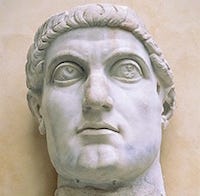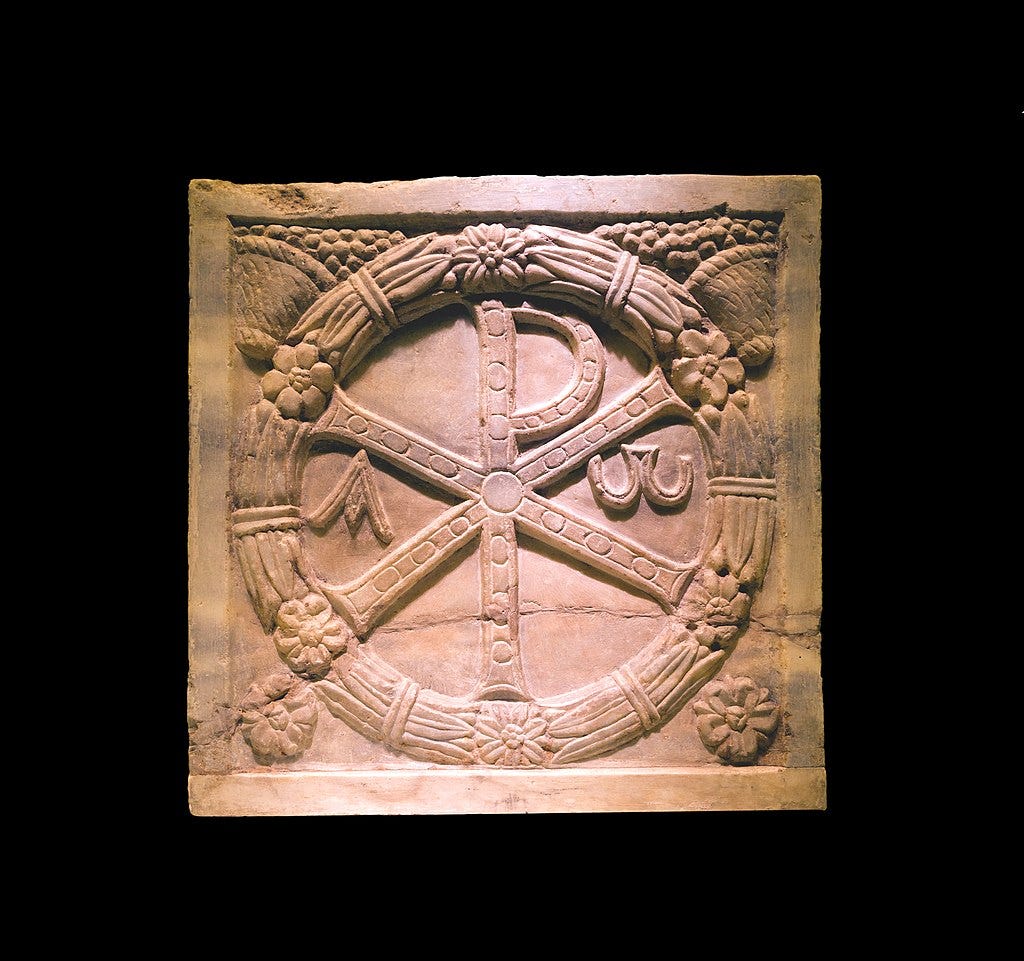Constantine the Great, Convert to Catholicism
In God's Providence, Christianity was spread by two converts, Paul and Constantine
House churches were the norm for the first 250 years after the death of Christ. The reason being, the Romans, and to some extent the Jews, pursued, picked up and persecuted the Christians relentlessly. Paul had warned them of this. They couldn’t build churches for that reason. They were an underground church until God intervened. That intervention was as grand as the conversion of Saul on the road to Demascus. Flavius Valerius Constantinus (Constantine the Great) was born on February 27 sometime after 280 A.D. at Naissus, now Nis, Serbia, some 380 miles north of Athens, Greece. He was the son of Flavius Valerius Constantius, an army officer, and his wife, Helena. Constantine was brought up in the Eastern Empire at the court of Emperor Diocletian at Nicomedia, now İzmit, Turkey, where he learned Latin and Greek and was exposed to Catholicism. Constantine surely must have witnessed during his youth the steadfastness of the thousands of Christian martyrs during the persecutions of Diocletian. In 293 A.D. Constantine’s father was raised to the rank of Caesar in the Western Empire. Constantine was eventually sent to his father’s court in the Western Empire. Weakened by illness, Diocletian stepped down from the throne of the Eastern Empire in May of 305 A.D., becoming the first Roman emperor to abdicate the position voluntarily. Diocletian had been emperor since 284 A.D. serving for 21 years. He lived out his retirement in his palace on the Dalmatian coast. His palace eventually became the core of the modern-day city of Split in Croatia.
Constantine’s father, the emperor of the Western Empire of Rome, died in battle in York, Britannia in 306 A.D. with Constantine at his side. Constantine was immediately proclaimed emperor by his troops. He began a march of his army to Rome to face Maxentius, a claimant to the throne. During his march, a vision appeared to Constantine in the sky and later that night in his dreams. The vision said “in this sign thou shalt conquer,” in the monogram of Christ.
He ordered his warriors to imprint Christ's monogram on their shields, even though most of them were pagans. The Christian symbol, the Chi-Rho, is formed from the first two Greek letters of the word "Christ," chi (X) and rho (Ρ), combined with Alpha and Omega, the first and last letters of the Greek alphabet. Maxentius’ army with over 100,000 men met Constantine’s army of about 20,000 men near the bridge over the Tiber called the Milvian Bridge. Maxentius suffered a complete defeat, losing his life in the Tiber on October 28, 312 A.D. Constantine was now the ruler of the entire Western Empire and a convert to Christianity by God himself. Saul was blinded but Constantine was made to see. In February 313 A.D. Constantine issued the Edict of Milan which afforded Christians complete liberty to practice their religion without persecution or harassment. Constantine ordered that all property seized or confiscated from the Christians during the Roman persecutions be returned to them at the expense of the State. Christians in the Eastern Empire, however, were still being persecuted.
After securing Rome, Emperor Constantine marched upon the eastern half of the Roman Empire and defeated Emperor Licinius in 324 A.D. Constantine then became sole Emperor of the entire Roman Empire and all Christians were finally free to openly practice their religion. He moved his capital to the ancient Greek city of Byzantium. Upon hearing of the Arian controversy in the Church after his arrival in Byzantium, Constantine, in consultation with Pope Sylvester I and St. Alexander, Bishop of Alexandria, Egypt, convoked the First Ecumenical Council of the Catholic Church, the First Council of Nicaea, in 325 A.D. Pope Sylvester, the Bishop of Rome since 314 A.D., was the first Pope to enjoy the peace of Christian life. Pope Sylvester held that position for 21 years, from 314 A.D. to 335 A.D., the year of his death. “During Sylvester's pontificate were built the great churches founded at Rome by Constantine, e.g. the basilica and baptistery of the Lateran near the former imperial palace where the pope lived, the basilica of the Sessorian palace (Santa Croce), the Church of St. Peter in the Vatican, and several cemeterial churches over the graves of martyrs.” https://www.newadvent.org/cathen/14370a.htm . St. Alexander succeeded St. Achillas as bishop of Alexandria in 313 A.D., the first bishop to enjoy Christian peace in northern Africa. St. Alexander, returning to Egypt after defeating Arianism, died 17 April, 326, not before recommending St. Athanasius as his successor. See a list of Popes, may of the early ones suffering martyrdom. https://www.newadvent.org/cathen/12272b.htm; List of bishops of Jerusalem https://en.wikipedia.org/wiki/Early_bishops_of_Jerusalem; List of bishops of Antioch https://en.wikipedia.org/wiki/List_of_patriarchs_of_Antioch; List of bishops of Alexandria https://en.wikipedia.org/wiki/List_of_patriarchs_of_Alexandria; List of bishops of Byzantium https://en.wikipedia.org/wiki/List_of_ecumenical_patriarchs_of_Constantinople
The Ecumenical Council was called because of the heresy preached by Arius (Arianism). Arius was made presbyter in 313 A.D, and had his own church district in Alexandria called Baucalis. This allowed Arius to preach the Scriptures officially. In 318, his quarrel with Bishop Alexander broke out over the fundamental truth of Christ’s divinity and substance. Bishop Alexander denounced Arius as a heretic. Arianism denies that the Son is of one essence, nature, or substance with God; He is not consubstantial (homoousios) with the Father, and therefore not like Him, or equal in dignity, or co-eternal, or within the real sphere of Deity. Seeing this dispute in the Church, Emperor Constantine decided on a convocation of an ecumenical council. The emperor himself, in very respectful letters, begged the bishops of every country to come promptly to Nicaea. Several bishops from outside the Roman Empire (e.g., from Persia) came to the Council. https://www.newadvent.org/cathen/01707c.htm
“In order to expedite the assembling of the Council, the emperor placed at the disposal of the bishops the public conveyances and posts of the empire; moreover, while the Council lasted, he provided abundantly for the maintenance of the members. The choice of Nicaea was favorable to the assembling of a large number of bishops. It was easily accessible to the bishops of nearly all the provinces, but especially to those of Asia, Syria, Palestine, Egypt, Greece, and Thrace. The sessions were held in the principal church, and in the central hall of the imperial palace. Arius and his writings were branded with anathema, his books were cast into the fire, and he was exiled to Illyria.” https://www.newadvent.org
The council produced a majority of the Nicene creed we still use today:
“We believe in one God the Father Almighty, Maker of all things visible and invisible; and in one Lord Jesus Christ, the only begotten of the Father, that is, of the substance [ek tes ousias] of the Father, God of God, light of light, true God of true God, begotten not made, of the same substance with the Father [homoousion to patri], through whom all things were made both in heaven and on earth; who for us men and our salvation descended, was incarnate, and was made man, suffered and rose again the third day, ascended into heaven and cometh to judge the living and the dead. And in the Holy Ghost. Those who say: There was a time when He was not, and He was not before He was begotten; and that He was made out of nothing (ex ouk onton); or who maintain that He is of another hypostasis or another substance [than the Father], or that the Son of God is created, or mutable, or subject to change, [them] the Catholic Church anathematizes.” https://www.newadvent.org/cathen/11044a.htm
The Filioque (concerning the Holy Spirit) was confirmed at the Council of Chalcedon in 451 A.D. Also proclaimed by the Council of Nicaea were several cannons with a few mentioned here.
“Canon 2: Rules to be observed for ordination, the avoidance of undue haste, the deposition of those guilty of a grave fault.
Canon 3: All members of the clergy are forbidden to dwell with any woman, except a mother, sister, or aunt.
Canon 4: Concerning episcopal elections.
Canon 5: Concerning the excommunicate.
Canon 6: Concerning patriarchs and their jurisdiction.
Canon 7: confirms the right of the bishops of Jerusalem to enjoy certain honours.
Canon 10: Lapsi who have been ordained knowingly or surreptitiously must be excluded as soon as their irregularity is known.
Canon 11: Penance to be imposed on apostates of the persecution of Licinius.
Canon 12: Penance to be imposed on those who upheld Licinius in his war on the Christians.
Canon 13: Indulgence to be granted to excommunicated persons in danger of death.
Canon 14: Penance to be imposed on catechumens who had weakened under persecution.
Canon 15: Bishops, priests, and deacons are not to pass from one church to another.
Canon 16: All clerics are forbidden to leave their church. Formal prohibition for bishops to ordain for their diocese a cleric belonging to another diocese.
Canon 17: Clerics are forbidden to lend at interest.
Canon 18: recalls to deacons their subordinate position with regard to priests.
Canon 20: On Sundays and during the Paschal season prayers should be said standing…” https://www.newadvent.org/cathen/11044a.htm
Just imagine. God in his providence converted a Roman Emperor who established the practice of Christianity as the official religion of the entire world. Worship of Greek and Roman gods eventually perished. And the word was eventually broadcast to the four corners of the earth. “When at last he felt the approach of death he received baptism, declaring to the bishops who had assembled around him that, after the example of Christ, he had desired to receive the saving seal in the Jordan, but that God had ordained otherwise, and he would no longer delay baptism. Laying aside the purple, the emperor, in the white robe of a neophyte, peacefully and almost joyfully awaited the end.” https://www.newadvent.org/cathen/04295c.htm Upon Constantine's death in 337 A.D., the city was renamed Constantinople in his honor. “The Byzantine Empire, also referred to as the Eastern Roman Empire or Byzantium, was the continuation of the Roman Empire primarily in its eastern provinces during Late Antiquity and the Middle Ages, when its capital city was Constantinople. It survived the fragmentation and fall of the Western Roman Empire in the 5th century A.D. and continued to exist for an additional thousand years until the fall of Constantinople to the Ottoman Turks in 1453 A.D.” https://en.wikipedia.org/wiki/Byzantine_Empire The Muslims changed the name of the city of Constantinople to its present name, Istanbul, Turkey.
I began this article with the intent to focus on the life of Emperor Constantine’s mother, Saint Helena. As I did research for the article, I wanted to lay a sufficient background in order to help explain her devotion to her son, Constantine, Christ and the Catholic Church. As you can see, I only mentioned her one time. This article will be the background for the next article on Saint Helena.



